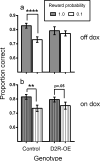The impact of motivation on cognitive performance in an animal model of the negative and cognitive symptoms of schizophrenia
- PMID: 25914923
- PMCID: PMC4880016
- DOI: 10.1037/bne0000051
The impact of motivation on cognitive performance in an animal model of the negative and cognitive symptoms of schizophrenia
Erratum in
-
Correction to Ward et al. (2015).Behav Neurosci. 2015 Aug;129(4):379. doi: 10.1037/bne0000085. Behav Neurosci. 2015. PMID: 26214211 Free PMC article.
Abstract
Interactions between motivation and cognition are implicated in producing functional impairments and poor quality of life in psychiatric patients. This interaction, however, is not well understood at either the behavioral or neural level. We developed a procedure for mice in which a cognitive measure, sustained attention, is modulated by a motivationally relevant signal that predicts reward probability on a trial-by-trial basis. Using this paradigm, we tested the interaction between motivation and cognition in mice that model the increased striatal D2 receptor activity observed in schizophrenia patients (D2R-OE mice). In control mice, attention was modulated by signaled-reward probability. In D2R-OE mice, however, attention was not modulated by reward-related cues. This impairment was not due to any global deficits in attention or maintenance of the trial-specific information in working memory. Turning off the transgene in D2R-OE mice rescued the motivational modulation of attention. These results indicate that deficits in motivation impair the ability to use reward-related cues to recruit attention and that improving motivation improves functional cognitive performance. These results further suggest that addressing motivational impairments in patients is critical to achieving substantive cognitive and functional gains.
(c) 2015 APA, all rights reserved).
Figures




Similar articles
-
Correction to Ward et al. (2015).Behav Neurosci. 2015 Aug;129(4):379. doi: 10.1037/bne0000085. Behav Neurosci. 2015. PMID: 26214211 Free PMC article.
-
Pharmacologic rescue of motivational deficit in an animal model of the negative symptoms of schizophrenia.Biol Psychiatry. 2011 May 15;69(10):928-35. doi: 10.1016/j.biopsych.2011.01.012. Epub 2011 Mar 16. Biol Psychiatry. 2011. PMID: 21414604 Free PMC article.
-
Dissociation of hedonic reaction to reward and incentive motivation in an animal model of the negative symptoms of schizophrenia.Neuropsychopharmacology. 2012 Jun;37(7):1699-707. doi: 10.1038/npp.2012.15. Epub 2012 Mar 14. Neuropsychopharmacology. 2012. PMID: 22414818 Free PMC article.
-
Schizophrenia in translation: dissecting motivation in schizophrenia and rodents.Schizophr Bull. 2012 Nov;38(6):1111-7. doi: 10.1093/schbul/sbs114. Epub 2012 Sep 26. Schizophr Bull. 2012. PMID: 23015686 Free PMC article. Review.
-
Insights About Striatal Circuit Function and Schizophrenia From a Mouse Model of Dopamine D2 Receptor Upregulation.Biol Psychiatry. 2017 Jan 1;81(1):21-30. doi: 10.1016/j.biopsych.2016.07.004. Epub 2016 Jul 14. Biol Psychiatry. 2017. PMID: 27720388 Free PMC article. Review.
Cited by
-
Overexpression of striatal D2 receptors reduces motivation thereby decreasing food anticipatory activity.Eur J Neurosci. 2020 Jan;51(1):71-81. doi: 10.1111/ejn.14219. Epub 2018 Nov 26. Eur J Neurosci. 2020. PMID: 30362616 Free PMC article.
-
Striatal dopamine D2 receptors regulate effort but not value-based decision making and alter the dopaminergic encoding of cost.Neuropsychopharmacology. 2018 Oct;43(11):2180-2189. doi: 10.1038/s41386-018-0159-9. Epub 2018 Jul 20. Neuropsychopharmacology. 2018. PMID: 30082890 Free PMC article.
-
Dissociating the effects of dopamine D2 receptors on effort-based versus value-based decision making using a novel behavioral approach.Behav Neurosci. 2020 Apr;134(2):101-118. doi: 10.1037/bne0000361. Behav Neurosci. 2020. PMID: 32175760 Free PMC article.
-
Motivational disturbances in rodent models of neuropsychiatric disorders.Front Behav Neurosci. 2022 Aug 16;16:940672. doi: 10.3389/fnbeh.2022.940672. eCollection 2022. Front Behav Neurosci. 2022. PMID: 36051635 Free PMC article. Review.
-
The instrumental role of operant paradigms in translational psychiatric research: Insights from a maternal immune activation model of schizophrenia risk.J Exp Anal Behav. 2022 May;117(3):560-575. doi: 10.1002/jeab.753. Epub 2022 Mar 23. J Exp Anal Behav. 2022. PMID: 35319781 Free PMC article. Review.
References
-
- Barch DM. The relationships among cognition, motivation, and emotion in schizophrenia: How much and how little we know. Schizophrenia Bulletin. 2005;31:875–881. - PubMed
-
- Bendiksby MS, Platt ML. Neural correlates of reward and attention in macaque area LIP. Neuropsychologia. 2006;44:2411–2420. - PubMed
Publication types
MeSH terms
Substances
Grants and funding
LinkOut - more resources
Full Text Sources
Other Literature Sources

